Apple's 11-inch MacBook Air (Core i7 1.8GHz) Review Update
by Anand Lal Shimpi on August 1, 2011 6:08 PM EST- Posted in
- Mac
- Apple
- Intel
- Core i7
- Sandy Bridge
- MacBook Air
Performance
In our 2011 MacBook Air review I presented a couple of numbers that showed up to a 27% increase in performance from the i7 over the stock i5 in the 11. I ran the upgraded 11 through our complete performance suite and came up with an average increase in performance of about 22%. Given the increase in base clock speed is only 12.5% for the i7, the rest of the performance improvement had to have come from the higher turbo ratios and larger L3 cache.
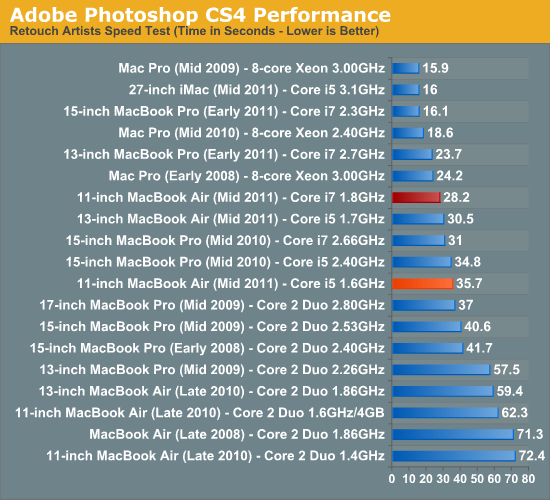
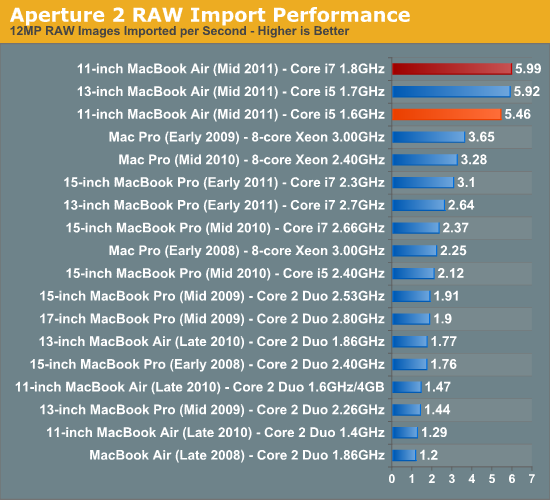
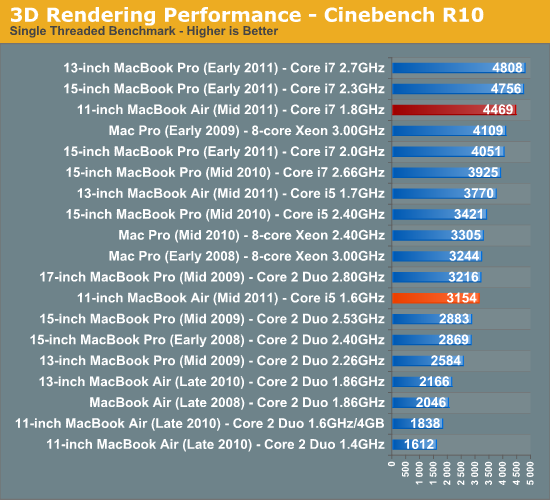
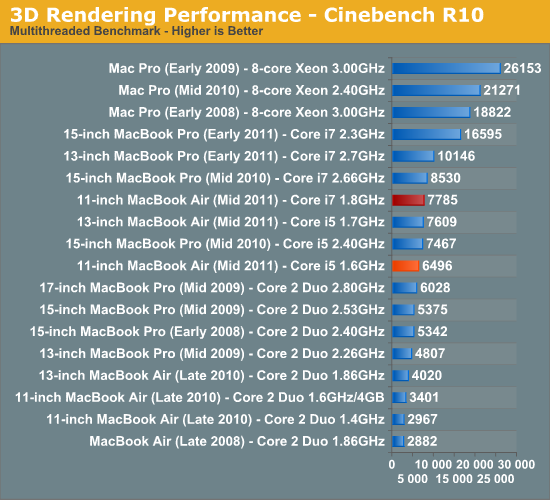
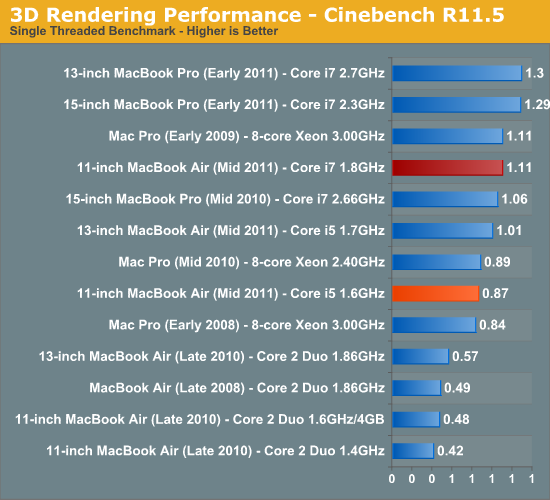
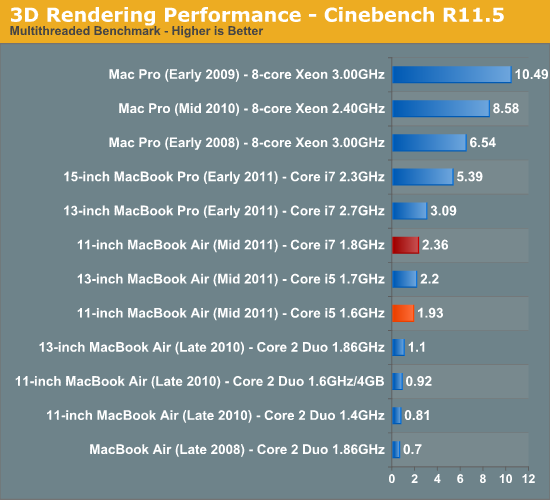
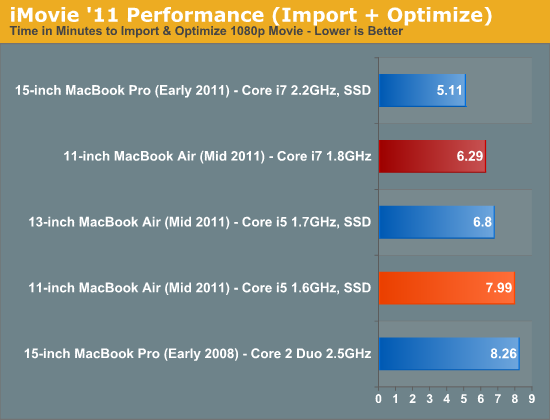
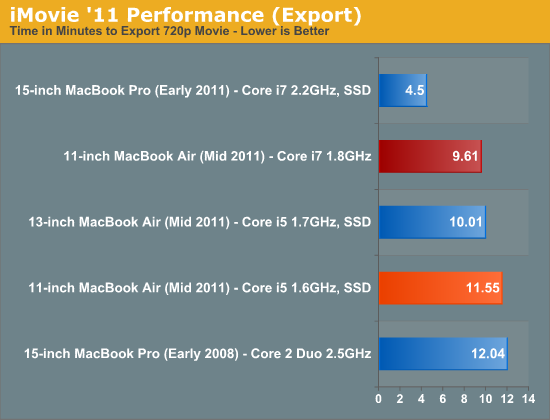


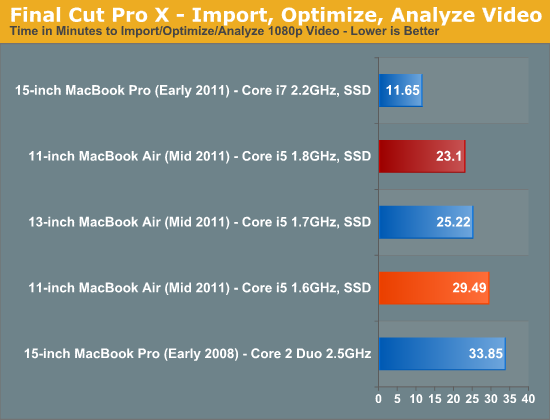
I tend to follow the 10% rule: performance improvements greater than 10% are noticeable. In the case of the 11-inch MacBook Air, the upgraded i7 delivers a noticeable increase in performance.
Note that due to the smaller chassis, the upgraded 11 isn't always as fast as the 13-inch MacBook Air with the same CPU. Maximum single threaded performance looks pretty similar but under a prolonged heavily threaded workload the upgraded 13 is actually a bit faster:
| Core i7 1.8GHz Comparison: 13-inch vs 11-inch MacBook Air | ||||||
| Cinebench R10 (1 thread) | Cinebench R10 (4 threads) | Cinebench 11.5 (4 threads) | ||||
| Core i7 1.8GHz (13-inch MBA) | 4083 | 8234 | 2.46 | |||
| Core i7 1.8GHz (11-inch MBA) | 4087 | 7785 | 2.36 | |||
The advantage is around 5% in Cinebench so I doubt it's anything noticeable.










55 Comments
View All Comments
Ratman6161 - Tuesday, August 2, 2011 - link
Anand, you say "peaked at 36.2W it quickly dropped back down to and remained at 31 - 33.5W throughout the majority of the render."Have you considered that the reason that the power peaks and then drops off is that the CPU hits its thermal limits and starts throttling? That would explain when the power usage drops back down.
I recently got in a new Dell 6420 which uses a mobile i5 Sandy Bridge CPU (don't remember which model). When I run Intel Burn Test on it while also monitoring it with CPUZ and Hardware monitor, you can see this happening. When the burn test starts, you see the cpu speed scale up. Then the temperatures start to climb and you can hear the fans running faster. About the time the CPU goes over 80C, you see the multiplier drop, resulting in a lower clock speed. As it cools a little the clock speed comes back up a little and fluctuates with temperatures but never again hits the peak it reached when the test initially started.
As I understand things, this is exactly how you would expect a Sandy Bridge CPU to operate, particularly in the confined spaces of a laptop and even more so in an ultra portable. Seems to me if its throttling though the i5 is probably doing this too.
marraco - Wednesday, August 3, 2011 - link
You can't work:http://homepage.mac.com/davehagan/glossy10.jpg
You can't work:
http://www.blogcdn.com/www.tuaw.com/media/2008/10/...
You can't work:
http://3.asset.soup.io/asset/1813/7075_ee11_500.jp...
YOU CAN'T SEE ANYTHING!
http://9.asset.soup.io/asset/1803/6089_5cab_500.jp...
http://images.anandtech.com/reviews/mac/MacBookPro...
Why all the babble about color gamut??? Is a portable computer. You can't carry it to the park, because, you can't see the screen!
You can't use it on your house, because you need to close all the windows, you need to switch off all the lights, and then you can't read your papers.
YOU NEED TO MOVE ALL YOUR FURNITURE JUST TO USE A MAC.
You can't move to other place on the table, because a reflection kills you.
You can't work with the windows behind you because of the reflections. You can't use the window behind the computer because of the light contrast (you need to put down all the internal lights).
neoplasm - Wednesday, August 3, 2011 - link
Checkmate!KPOM - Wednesday, August 3, 2011 - link
The MacBook Air does not have a glass cover on top of the anti-glare coating. it is nowhere near as reflective as the MacBook Pro. I have no issues using it at home during the day or at night, and I get a lot of natural light in my apartment. I also don't have an issue using it on planes or in sunny airport lobbies. It's pretty easy to move the screen around so that light isn't shining directly on it.snakeInTheGrass - Monday, August 22, 2011 - link
I'm trying to see myself in my MacBook Air 11" screen right now. I have a window to the right of my desk, another behind me, and unless I align the screen to directly reflect the window I can't see any effect from it. Nice photos anyway, but I don't really think they're very representative of the Air screen.cantus - Saturday, August 6, 2011 - link
in such detailed reviews of the macbook airs as found on anandtech it is surprising if not even puzzling to not find a single word on fan noise in these highly compacted machines.
for many users sound levels are a key issue as the growing silent computing market shows and a clear evaluation of the sound levels of these machines is essential topic for any serious review to comment on. that anandtech, while providing the probably most in-depth reviews of the mac book airs does not do so is strange to say the least.
OrcaNZ - Sunday, August 7, 2011 - link
Thanks for a very informative review - I have the 11" i7 - and use it for work and casual gaming (CiV V etc). Great machine and honesty the best ultra portable laptop I have ever owned. Coming from a 2010 13" Macbook Pro, I found the weight saving of lugging it around everyday the biggest benefit. Best Apple product I have used to date.h00ligan76 - Tuesday, August 9, 2011 - link
You know, I love the anandtech reviews.. let's start with that.However the inconsistencies in testing make it difficult for one to evaluate for purchase - whether they be comparing the technology.
For example - all of the tests for imports exports were done with a SSD in a macbook pro... well for people on the budget of the air / base model, it doesn't translate well into real world differences.
While I understand the need or desire to negate the disk differences, I also think it would be a valuable addition to show them as one could then specifically see how much of an impact the SSD has to counter the weaker processor or vid card.
In the real world, most people are on budgets and don't necessarily order top of the line custom built.. more working pros for example will buy base models to amortize depreciation better.
As always, thanks for the great review.
justinyuen - Thursday, August 18, 2011 - link
I appreciated the deep look at the MacBook Air and it was helpful with both my purchasing decision and the blog post I just wrote comparing the 11" and the 13" for FMYI:http://www.fmyi.com/blog/single/the_perfect_laptop...
arunbala - Wednesday, August 24, 2011 - link
Thanks a lot for this review. I was specifically interested in the performance tradeoff from the i5 1.7GHz to the i7 1.8GHz and the temperature implications. The data presented here clearly shows a major downside as far as heat goes when packing a i7 into a 11 inch air. I had the 11-inch air with the upgraded CPU for 10 days. The excess heat was a major downer for me. Once this review confirmed what I felt with real world use, I decided I wanted to switch to the 13". As much as I love the 11-inch's portability, Apple needs to work on the heat aspect and cut it down significantly. From the previous gen 1.4GHz core 2 duo to the core i7 we see a clear 15 degree C temp increase on the 11 inch. This is a major deal breaker for a "lap"top. I have had my 13" for 3 weeks now and I'm glad I made the switch.Arun